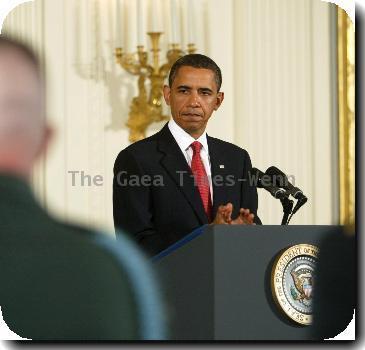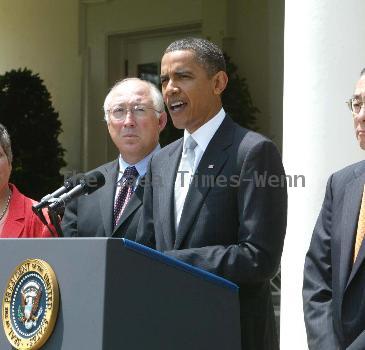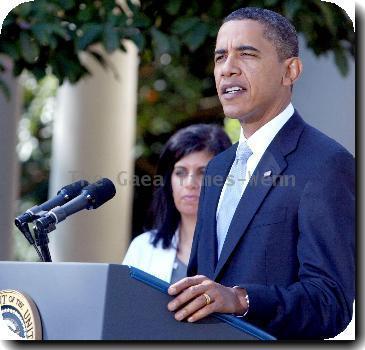BP: Mile-long tube starts sucking oil up to tanker as crews gain first handle on Gulf leak
By Jeffrey Collins, APSunday, May 16, 2010
BP: Mile-long tube sucking oil away from Gulf well
NEW ORLEANS — Oil company engineers on Sunday finally succeeded in keeping some of the oil gushing from a blown well out of the Gulf of Mexico, hooking up a mile-long tube to funnel the crude into a tanker ship after more than three weeks of failures.
Millions of gallons of crude are already in the water, however, and researchers said the black ooze may have entered a major current that could carry it through the Florida Keys and around to the East Coast.
BP PLC engineers remotely guiding robot submersibles had worked since Friday to place the tube into a 21-inch pipe nearly a mile below the sea. After several setbacks, the contraption was hooked up successfully and funneling oil to a tanker ship. The oil giant said it will take days to figure out how much oil its contraption is sucking up.
The blown well has been leaking for more than three weeks, threatening sea life, commercial fishing and the coastal tourist industry from Louisiana to Florida. BP failed in several previous attempts to stop the leak, trying in vain to activate emergency valves and lowering a 100-ton container that got clogged with icy crystals.
A researcher told The Associated Press on Sunday that computer models show the oil may have already seeped into a powerful water stream known as the loop current, which could propel it into the Atlantic Ocean. A boat is being sent later this week to collect samples and learn more.
William Hogarth, dean of the University of South Florida’s College of Marine Science, said one model shows oil has already entered the current, while a second shows the oil is 3 miles from it — still dangerously close. The models are based on weather, ocean current and spill data from the U.S. Navy and the National Oceanic and Atmospheric Administration, among other sources.
Hogarth said it’s still too early to know what specific amounts of oil will make it to Florida, or what damage it might do to the sensitive Keys or beaches on Florida’s Atlantic coast. He said claims by BP that the oil would be less damaging to the Keys after traveling over hundreds of miles from the spill site were not mollifying.
“This can’t be passed off as ‘it’s not going to be a problem.’” Hogarth said. “This is a very sensitive area. We are concerned with what happens in the Florida Keys.”
BP had previously said the tube, if successful, was expected to collect most of the oil gushing from the well. On Sunday, the company said it was too early to measure how much crude was being collected and acknowledged the tube was no panacea.
“It’s a positive move, but let’s keep in context,” said Kent Wells, BP’s senior vice president for exploration and production. “We’re about shutting down the flow of oil from this well.”
Crews will slowly ramp up how much oil the tube collects over the next few days. They need to move slowly because they don’t want too much frigid seawater entering the pipe, which could combine with gases to form the same ice-like crystals that doomed the previous containment effort.
The first chance to choke off the flow for good should come in about a week. Engineers plan to shoot heavy mud into the crippled blowout preventer on top of the well, then permanently entomb the leak in concrete. If that doesn’t work, crews also can shoot golf balls and knotted rope into the nooks and crannies of the device to plug it, Wells said.
The final choice to end the leak is a relief well, but it is more than two months from completion.
Top officials in President Barack Obama’s administration cautioned that the tube “is not a solution” to the spill and said they are closely monitoring the situation.
“We will not rest until BP permanently seals the wellhead, the spill is cleaned up, and the communities and natural resources of the Gulf Coast are restored and made whole,” Secretary of Homeland Security Janet Napolitano and Secretary of the Interior Ken Salazar said in a joint statement.
Meanwhile, scientists warned of the effects of the oil that has already leaked into the Gulf. Researchers said miles-long underwater plumes of oil discovered in recent days could poison and suffocate sea life across the food chain, with damage that could endure for a decade or more.
Researchers have found more underwater plumes of oil than they can count from the well, said Samantha Joye, a professor of marine sciences at the University of Georgia. She said careful measurements taken of one plume showed it stretching for 10 miles, with a 3-mile width.
The hazardous effects of the plume are twofold. Joye said the oil itself can prove toxic to fish swimming in the sea, while vast amounts of oxygen are also being sucked from the water by microbes that eat oil. Dispersants used to fight the oil are also food for the microbes, speeding up the oxygen depletion.
“So, first you have oily water that may be toxic to certain organisms and also the oxygen issue, so there are two problems here,” said Joye, who’s working with the scientists who discovered the plumes in a recent boat expedition. “This can interrupt the food chain at the lowest level, and will trickle up and certainly impact organisms higher. Whales, dolphins and tuna all depend on lower depths to survive.”
Conservationists in Florida said oil could wreak havoc in the Keys or the environmentally fragile Everglades.
“Obviously this is a fear that we had about where the oil might go next,” said John Adornato, regional director for the National Parks Conservation Association.
Oil has been spewing since the rig Deepwater Horizon exploded April 20, killing 11 people and sinking two days later. The government shortly afterward estimated the spill at 210,000 gallons — or 5,000 barrels — a day, a figure that has since been questioned by some scientists who fear it could be far more. BP executives have stood by the estimate while acknowledging there’s no way to know for sure.
News of the tube’s success was met with tempered enthusiasm by the leader of a coastal parish in Lousiana that includes environmentally sensitive marshes and islands.
“It’s definitely good news,” Plaquemines Parish President Billy Nungesser said after a BP vice president called to brief him.
“It will be better news when they get it stopped,” he said, noting the underwater oil plumes. “We have a large mess out there.”
Collins reported from Hammond. Associated Press Writers Michael Kunzelman in New Orleans, Shelia Byrd in Jackson, Miss., and Christine Armario in Miami contributed to this report.
(This version CORRECTS that boat is being sent later this week sted next week.) )
Tags: Accidents, Animals, Barack Obama, Coastlines And Beaches, Environmental Concerns, Florida, Hammond, Louisiana, Mammals, New Orleans, North America, Oceanography, Oceans, United States




